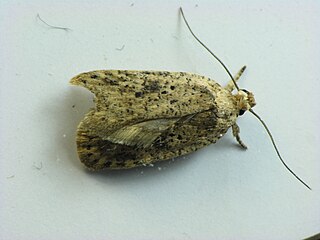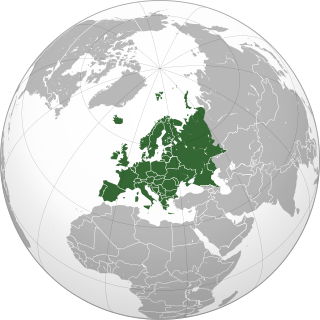
Lymantria dispar, the gypsy moth, are moths in the family Erebidae. Lymantria dispar covers many subspecies, subspecies identification such as L. d. dispar or L. d. japonica leaves no ambiguity in identification. Lymantria dispar subspecies have a range which covers in Europe, Africa, Asia, North America and South America.

The Pyralidae, commonly called pyralid moths, snout moths or grass moths, are a family of Lepidoptera in the ditrysian superfamily Pyraloidea. In many classifications, the grass moths (Crambidae) are included in the Pyralidae as a subfamily, making the combined group one of the largest families in the Lepidoptera. The latest review by Eugene G. Munroe & Solis, in Kristensen (1999) retains the Crambidae as a full family of Pyraloidea.
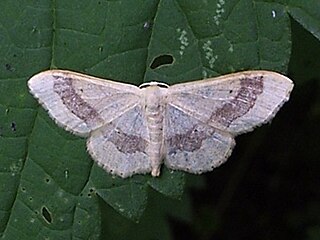
The riband wave is a moth of the family Geometridae. The species was first described by Carl Linnaeus in his 1758 10th edition of Systema Naturae.

The common pug(Eupithecia vulgata) is a moth of the family Geometridae. It is a common species across the Palearctic region, the Near East and North Africa. It ranges from the Atlantic coast of Ireland and Portugal across Europe, the Middle East and Central Asia to the Russian Far East (Priamurje) and Korea.

Ptycholoma lecheana, the Leche's twist moth, is a moth of the family Tortricidae. It is found in Europe, China, Korea, Japan, Russia and Asia Minor.

Notocelia rosaecolana is a moth of the family Tortricidae. It is found in the Palearctic ecozone, where it has been recorded from China, Mongolia, Korea, Japan, Iran, Central Asia, Russia and Europe.

Celypha cespitana is a moth of the family Tortricidae. It is found in the Palearctic ecozone, from western Europe to the Ural Mountains, Transcaucasia, Asia Minor, the Near East, Iran, Russia, north-eastern China (Manchuria), Korea and Japan. It is also found in the Nearctic ecozone.
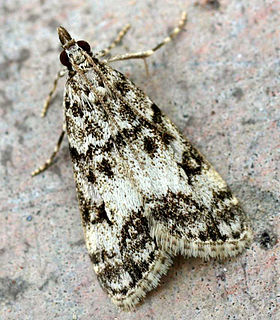
Eudonia lacustrata is a species of moth of the family Crambidae described by Georg Wolfgang Franz Panzer in 1804. It is found in Europe, north-west Africa, Asia from Turkey, Iran and Syria to Siberia and the western part of China (Hunan). The subspecies E. lacustrata persica is found in Iran and Armenia.

Minoa murinata, the drab looper, is a moth of the family Geometridae. The species was first described by Giovanni Antonio Scopoli in his 1763 Entomologia Carniolica. It can be found in southern and central Europe, Anatolia, the Caucasus and the mountains of central Asia and Mongolia.

Eupithecia tantillaria, the dwarf pug, is a moth of the family Geometridae. It was described by Jean Baptiste Boisduval in 1840. The species can be found in the Palearctic ecozone.

Oxyptilus parvidactyla is a brown coloured moth of the family Pterophoridae. It is found in almost all of Europe, as well as Russia, Asia Minor and North Africa.
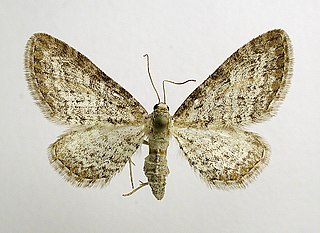
Eupithecia subumbrata, the shaded pug, is a moth of the family Geometridae. The species was first described by Michael Denis and Ignaz Schiffermüller in 1775. It is found from Mongolia and the Altai Mountains through Siberia, central Asia, Asia Minor and Russia to western Europe and from central Scandinavia to the Mediterranean region.
Stenoptilia stigmatodactylus is a moth of the family Pterophoridae. It is found in western, central and Mediterranean Europe, extending into Asia Minor and North Africa. It is also known from Iran, Russia and Armenia.
Ancylolomia palpella is a species of moth in the Crambidae family described by Michael Denis and Ignaz Schiffermüller in 1775. It is found in Belgium, France, Spain, Portugal, Italy, Austria, the Czech Republic, Slovakia, Poland, Hungary, Croatia, Romania, Bulgaria, the Republic of Macedonia, Albania, Greece, Ukraine, Russia, Transcaucasia, Asia Minor, Lebanon, the Palestinian territories, Iraq, Syria, Iran and Central Asia.

Eupithecia silenicolata is a moth in the family Geometridae. It is found from southern Europe and Morocco to western Asia, Iran and Pakistan. In the north, the range extends to southern Switzerland, Austria and northern Italy.
The following are the regional Lepidoptera lists by continent. Lepidoptera is the insect order consisting of both the butterflies and moths.

Chionodes distinctella, the eastern groundling, is a moth of the family Gelechiidae. It is found in almost all of Europe, as well as most of Russia, Kazakhstan, Central Asia and North Africa. The habitat consists of dry, rocky heath and meadows and the verges and rough pastures.

Lacydes spectabilis is a moth of the family Erebidae. It was described by Tauscher in 1806. It is found in south-eastern Ukraine, eastern European Russia, western Siberia, Kazakhstan, Central Asia, Armenia, eastern Turkey, Turkmenistan, Afghanistan, China (Xinjiang) and southern Mongolia.
Epinotia nemorivaga, the bearberry bell, is a species of moth in the family Tortricidae. It is found in Europe and Asia.

Thiodia citrana, the lemon bell, is a species of moth of the family Tortricidae. It is found in China, Japan, Iran, Asia Minor, Turkmenistan, Russia, Kazakhstan, North Africa and Europe. The habitat consists of rough grasslands and dry pastures.


